Why This Is Important
If you need to treat someone in your house for the flu, you will want to do as much as you can to try to keep the illness from spreading to other family members.
In this section, we will deal with the practical realities of how to isolate someone and provide good infection control in an out-of-hospital setting. Unless we work in a hospital, these skills are no longer taught, as they were in the population before modern medicine.

In order to be able to do these things you need to obtain adequate supplies and learn
NOW –
once someone is sick, you will want to be able to move fast, and there will probably be no time (nor outside help) to gather supplies.
Guidelines for Minimizing the Spread of Virus
1. Set up a separate room after a pandemic starts, before anyone is sick.
- Pre-position supplies (see below for a suggested list and amounts). Place hand cleaning materials throughout the house.
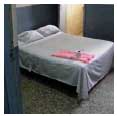
- Remove all unneeded items from the room. This will make cleaning and disinfection easier. Consider removing curtains.
- If possible choose a room that is close to its own bathroom. If no separate bathroom is possible, consider preparing for an RV chemical toilet or other separate toilet.
- Choose a room that is as far away from the rest of the family as is feasible. Possibilities include: guest house, mobile home/camper/trailer house, loft above a garage, spare bedroom, partition of a larger room (to be screened off with plastic).
2. Infection control guidelines: - Separate the sick person from other people in the household to the extent possible. Use a separate room and bathroom, if possible.
- Limit the number of persons coming into the household to those who are absolutely essential for care giving. No visitors other
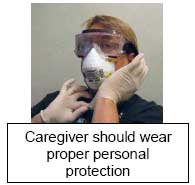 than the caregiver.
than the caregiver.
- Hand hygiene. This means thorough hand washing with soap and water, or using hand sanitizer.
- Source control. The sick person should cover the nose/mouth with a tissue or their sleeve when coughing and dispose of tissues in a waste container with a plastic bag lining. The caregiver should ideally have a respirator and eye protection on before entering the separate area (masks are non-reusable, goggles need cleaning).
- Gloves. Disposable gloves should be worn by the caregiver before touching the sick person and while disinfecting the room. Always wash your hands after taking the gloves off. Dispose of gloves in a plastic bag-lined waste container when done.
- Laundry. Always put gloves on before handling any laundry – bedding, towels, clothing, etc. Carefully place laundry in a plastic bag until time to launder. Wash separately from other household laundry in warm water and detergent.
- Drinks/Meals. Use disposable cups, bowls, plates and utensils to save cleanup time and reduce the chance of the virus spreading.
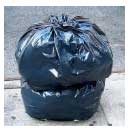

- Household waste. Gloves, tissues, paper plates, etc. from the separate room should be put in a kitchen garbage bag and disposed of with other household waste.
- Feces and blood. Transmission of the flu virus through feces and blood is possible. To be safe, OSHA recommends using gown and gloves, and treating materials as potentially infectious. Place in a separate bag and then seal the bag and dispose of it.
3. Cleaning and disinfection.

- Remove clothing items that are soiled by the sick person and place them in the garbage bag for laundry. Close the bag when done.
- Clean and disinfect surfaces that are frequently touched by the sick person. Do this daily, if possible. Do NOT use a spray bottle. Use a bucket, and rag or paper towel. A good disinfecting solution is bleach diluted with water.
Guidelines: 1. Wear either new disposable gloves or disinfected reusable household gloves each time the cleaning and disinfecting process begins.
2. Each day, mix 2 tablespoons of unscented household bleach into a bucket holding 1 quart of water. This cleaning solution will be good for
one day only.
3. Dip a rag or paper towel into the bleach solution and wring it out.
4. Thoroughly wipe down hard surfaces with the rag, dipping it into the bleach solution as often as needed. Used rags go in the laundry bag for this room. Used paper towels go in the plastic bag-lined garbage can.
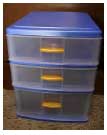
4. Supplies: Gather adequate supplies now and store in a container kept in the room planned to be used for patients. Products and suggested amounts in the list below give an idea for supplies for one person, sick for two weeks. These are rough guidelines only and circumstances will vary.
- Bleach: One quart of regular, unscented household bleach. This will be mixed with water, when needed, to kill the virus. Important – Bleach has a short shelf life. Replace with a new bottle every three months.
- Water: At least six gallons, for mixing with bleach.
- Buckets: for mixing the bleach solutions, as a vomit receptacle, etc.
- Rags (at least 7) to wipe surfaces with the bleach solution. These can be sanitized and reused. Or, store paper towels.
- Trash bags. At least 30 sturdy, large “kitchen garbage bags” with selfclosing ties. These will be used for garbage, laundry, etc. (figure 2 per day).
- Straws. These make it MUCH easier to feed someone in bed. For example, rice cereal can be mixed into a flavored slurry to get some carbs/binders into a sick person, and can be drunk with a straw.
- Bedpan
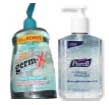 Hand sanitizer (at least 60% alcohol): Many bottles of hand sanitizer for the sick room and for keeping around the house.
Hand sanitizer (at least 60% alcohol): Many bottles of hand sanitizer for the sick room and for keeping around the house.
- Disposable gloves (latex or nitrile if allergic to latex): one box (about 30 pairs) usually about $4/box – is a good start.
- Respirators: depends on what type you have chosen.
- Reusable P-100s: store 2 extra filters
- Disposable N-95s or N100s: 28
- Eye Protection: 1 pair of goggles to protect your eyes from a patient's sneezing or coughing.
- Medical supplies: see ‘Treating the flu: Home Treatment Resources’ for medical supplies. Be sure to include the ingredients for the Oral Rehydration Solution. This is critical to keeping the patient well hydrated. Here is one recipe:
Oral Re-hydration Solution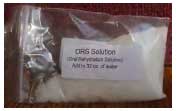
➢ 1 level teaspoon of table salt
➢ 3 tablespoons of white sugar
➢ Powdered drink mix (for flavoring) in a sandwich bag.
-Using plastic sandwich bags, pre-measure the above ingredients, combining all ingredients into single serving bags. Make a few bags for each family member. Label each “Oral Re-hydration solution.”
-When needed, each sandwich bag is added to 1 quart of water.
Include the water in your container. Get fluids in as much as possible, as long as the patient is conscious.
-for more information, see Rehydration Project |
- Drinkable water: at least 14 gallons nearby (one per day for two weeks) – to minimize need to move around the house.
For the rest of the family, consider: 1. Food and Water: 
- Easy, ready-to-eat meals for the rest of the family for 2 weeks while caretaker cares for sick person. Train children now if old enough to be able to help out in a crisis. For example, how to fix their own food.
- Easy-to-eat food for sick person recovering from serious illness (chicken soup packets, baby rice cereal, ginger ale, saltines, and other, well tolerated comfort foods.
2. Disposable cups, bowls, plates and utensils: Get 3 sets PER PERSON, per day. Using these will minimize spreading the virus and reduce work.
Additional information. The Centers for Disease Control and Prevention (CDC) provided guidance for another contagious disease, Severe Acute Respiratory Syndrome (SARS). Their three-page download (link below) provides excellent guidance on using a sick room at home:
Infection Control in Healthcare, Home and Community Settings